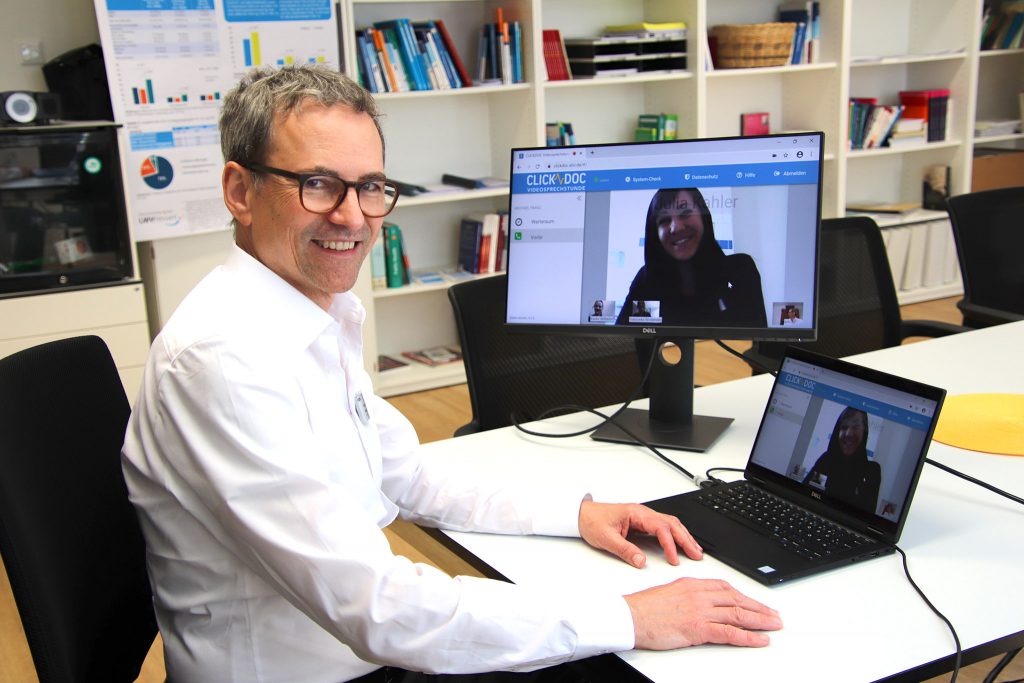The Corona pandemic has turned the world upside down. Now, leading guidelines advise keeping distance from others and reducing social contact. But these measures have also raised an enormous challenge for daily therapy in psychiatric hospitals — for successful treatment, above all, human contact is needed. For this reason, Vitos Giessen-Marburg has found an answer: Teletherapy as part of a comprehensive treatment concept. Prof. Dr. Michael Franz, Medical Director at the Vitos Clinic Giessen-Marburg, explains how it works.
Author: Susanne Richter-Polig, Vitos Klinik für Psychiatrie und Psychotherapie, Giessen und Marburg

Professor Franz, what is your concept of “teletherapy?”
Prof. Dr. Michael Franz: Teletherapy offers the possibility of treating patients virtually. The therapy offers procedures, and contact design is based on what would occur in a real medical ward – only we use the help of a telephone or video connection. Several people can take part in such meetings, so that visits and meetings are possible for individuals or even small groups. In the near future we plan to offer ergotherapy and exercise therapy with short video clips. An online skills group is being planned, and much more. Physical contact is usually only made once during the recording, as a physical examination is also part of the procedure.
What is the current procedure during a week of teletherapy with patients?
Franz: As a patient, you have daily morning contact with the nursing staff, plus individual contact or contact in a small group within a morning meeting to discuss patient needs. At the moment there is a daily one-on-one interview with the therapist, a psychologist or doctor, as well as reference care interviews. Once a week there’s a visit to the senior physician, and there’s a weekly medical visit. In addition, members of the Department of Social Services introduce themselves to each patient and offer support. As mentioned, all of these services are being expanded, step by step. They are based on the “blended care” approach, an integration of online intervention into regular, face-to-face psychotherapy, which is currently considered the gold standard. For this reason, initially there’s direct contact with a therapist when a patient is admitted, which is also used to collect the physical information about the patient.
What technical equipment do patients need to participate in this therapy? Is a smartphone enough?
Franz: The minimum requirement is a functioning telephone. We can achieve a great deal with this alone. Of course, a desk-top computer or device that has a camera and microphone is ideal for a connection with image and sound, such as with the ClickDoc program. Here, the patient and several doctors see each other, for example, during a visit. They can upload, exchange or view documents together, such as a weekly therapy plan. For patients, there’s even a virtual waiting room. In psychiatry, however, we also want to reach patients who can’t have technical equipment. Therefore, we also work with normal telephone conversations. Telephone contact should not be underestimated. In the treatment of borderline patients in acute crises, for example, we’ve been using telephone coaching for a long time, and it’s proven to be very effective.
For whom is teletherapy suitable?
Franz: In principle, it depends more on the reliability and ability to coordinate with a patient than on his diagnosis. However, it’s in the nature of things that illnesses that can be influenced more by language therapy benefit more than those that require a structured framework and short contacts. As a rule, depression, anxiety and obsessive-compulsive disorders, borderline disorders, trauma disorders, personality and somatoform disorders can be well treated. Patients with acute external self-endangerment or suicidal tendencies are, of course, excluded. There are also limits for topics such as acute detoxification or dissocial disorders. It must always be assessed individually whether teletherapy is the treatment of choice for a patient or not.
Personal contact between people is very important. A virtual offer is not the same as a face-to-face meeting. Why can patients still benefit from virtual treatment?
Franz: We have a so-called bonding system. This refers to the parts in our brain that carry and process our relationships with other people. We know that this attachment system has a very calming and downright health-promoting effect. We also know that therapy results are strongly influenced by the quality of the therapeutic relationship. However, it’s an open question whether a bond becomes effective only when someone is sitting face-to-face with another person. Data from studies on online therapies and the aforementioned “blended care” suggest that good temporary bonds can also develop when a large part of the interaction takes place over the phone or with video support. If the contact is good, our brain completes the connection to the counterpart to a certain extent. This is why good voice transmission is so important. However, there are individual people who do not succeed with this. These patients are then usually dependent on the physical presence of a counterpart to build a relationship.
After the corona pandemic, will teletherapy continue to be an integral part of Vitos Giessen-Marburg’s range of therapies?
Franz: Our teletherapy concept is an innovation and, at the same time, a contemporary format, even beyond the current pandemic. Even before the crisis, the areas of application, availability and evidence base of online and teletherapy in an international context were constantly increasing, especially since previously unreached patients can be reached with this format. The question was not whether such a comprehensive teletherapy offer would exist at some point in time, but when and where. Now we’ve started, and at Vitos Clinic, we will be ready at a very early stage of this development with an elaborate therapeutic concept and proven experience. With the help of quality indicators, we will evaluate our concept and critically assess it. An efficacy study in the narrower sense should be prospective and include a control.
This interview by Prof. Dr. Michael Franz was first published on the Vitos-Blog.

